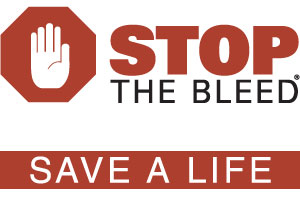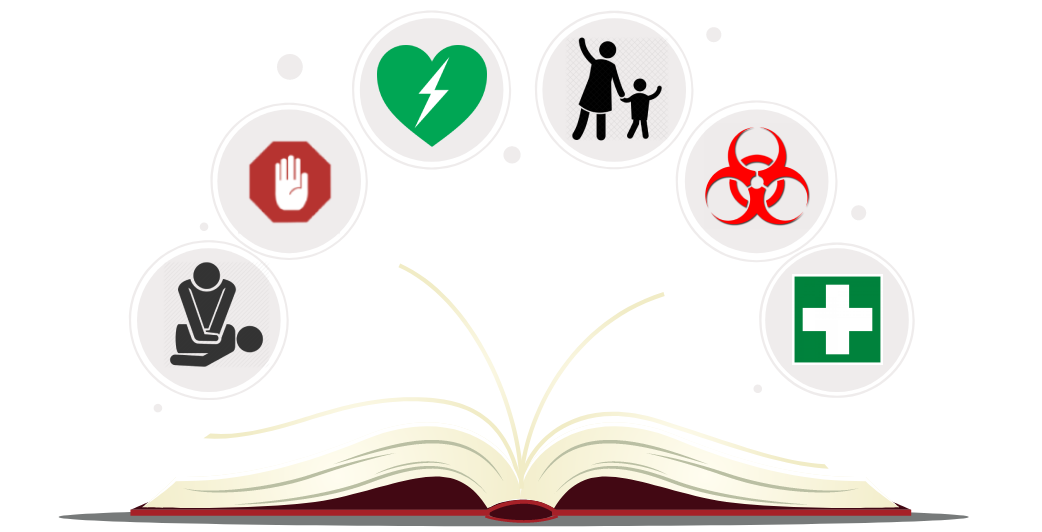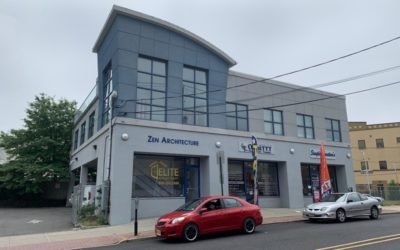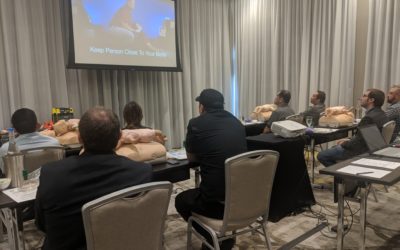TRAINING COURSES
First In Response Enterprises is your first choice for preparedness training in New Jersey & New York.




We offer blended learning, classroom training, and on-site training in Bleeding Control (BCon), Bloodborne Pathogens (BBP), Cardiopulmonary Resuscitation (CPR), Child and Babysitting Safety (CABS), and First Aid for first responders, medical professionals, and the public. Certifications are provided by the American College of Surgeons (ACS), American Heart Association (AHA), American Safety & Health Institute (ASHI), and New Jersey Department of Health (NJ DOH).
Find The Right Course For You

AHA - Basic Life Support (BLS)
The American Heart Association (AHA) Basic Life Support (BLS) course trains participants to promptly recognize several life-threatening emergencies, give high-quality chest compressions, deliver appropriate ventilations and provide early use of an AED. Reflects science and education from the American Heart Association Guidelines Update for CPR and Emergency Cardiovascular Care (ECC).
Who should take this course?
The AHA’s BLS course is designed for healthcare professionals and other personnel who need to know how to perform CPR and other basic cardiovascular life support skills in a wide variety of in-facility and prehospital settings. Available in two tracks: pre-hospital and in-facility.
| Training Method: | Classroom & On-Site |
| Course Length: | Up to 4 Hours, 30 Minutes |
| Training Method: | Blendend |
| Course Length: | Up to 2 Hours Online & 1 Hour, 10 Minutes Hands-On |
| Prerequisites: | A HeartCode BLS certificate must be submitted prior to completing Hands-On portion. |
Certification Period: 2 Years
AHA - Heartsaver CPR AED
The American Heart Association (AHA) Heartsaver CPR AED course trains participants to give CPR, and use an automated external defibrillator (AED) in a safe, timely, and effective manner. Reflects science and education from the American Heart Association Guidelines Update for CPR and Emergency Cardiovascular Care (ECC).
Who should take this course?
The AHA Heartsaver CPR AED course is designed for anyone with limited or no medical training who needs a course completion card in CPR and AED use to meet job, regulatory, or other requirements.
| Training Method: | Classroom & On-Site |
| Course Length: | Up to 4 Hours, 30 Minutes |
| Training Method: | Blendend |
| Course Length: | Up to 1 Hour, 45 Minutes Online & 1 Hour, 30 Minutes Hands-On |
| Prerequisites: | A Heartsaver CPR AED Online certificate must be submitted prior to completing Hands-On portion. |
Certification Period: 2 Years
AHA - Heartsaver First Aid
The American Heart Association (AHA) Heartsaver First Aid course trains participants first aid basics for the most common first aid emergencies, including how to recognize them, how to call for help, and how to perform lifesaving skills. Reflects science and education from the American Heart Association Guidelines Update for CPR and Emergency Cardiovascular Care (ECC) and the 2015 AHA/Red Cross Guidelines for First Aid.
Who should take this course?
The AHA Heartsaver First Aid course is designed for anyone with limited or no medical training who needs a course completion card in first aid to meet job, regulatory, or other requirements.
| Training Method: | Classroom & On-Site |
| Course Length: | Up to 3 Hours |
| Training Method: | Blendend |
| Course Length: | Up to 3 Hours, 30 Minutes Online & 30 Minutes Hands-On |
| Prerequisites: | A Heartsaver First Aid Online certificate must be submitted prior to completing Hands-On portion. |
Certification Period: 2 Years
AHA - Heartsaver First Aid CPR AED
The American Heart Association (AHA) Heartsaver First Aid CPR AED course trains participants to provide first aid, CPR, and use an automated external defibrillator (AED) in a safe, timely, and effective manner. Reflects science and education from the American Heart Association Guidelines Update for CPR and Emergency Cardiovascular Care (ECC).
Who should take this course?
The AHA Heartsaver First Aid CPR AED course is designed for anyone with little or no medical training who needs a course completion card for their job, regulatory (e.g., OSHA), or other requirements, o anyone who wants to be prepared for an emergency in any setting.
| Training Method: | Classroom & On-Site |
| Course Length: | Up to 7 Hours |
| Training Method: | Blendend |
| Course Length: | Up to 4 Hours Online & 2 Hours 30 Minutes Hands-On |
| Prerequisites: | A Heartsaver First Aid CPR AED Online certificate must be submitted prior to completing Hands-On portion. |
Certification Period: 2 Years
AHA - Heartsaver Pediatric First Aid CPR AED
The American Heart Association (AHA) Heartsaver Pediatric First Aid CPR AED course trains participants how to respond to and manage illnesses and injuries in a child or infant in the first few minutes until professional help arrives. Reflects science and education from the American Heart Association Guidelines Update for CPR and Emergency Cardiovascular Care (ECC) and the 2015 AHA/Red Cross Guidelines for First Aid.
Who should take this course?
The AHA Heartsaver Pediatric First Aid CPR AED course is designed for anyone involved in childcare who have a duty to respond to illnesses and injuries in a child or infant in the first few minutes until professional help arrives. Including: childcare workers, teachers, camp counselors, etc.
| Training Method: | Classroom & On-Site |
| Course Length: | Up to 9 Hours |
| Training Method: | Blendend |
| Course Length: | Up to 2 Hours, 30 Minutes Online & 2 Hours 30 Minutes Hands-On |
| Prerequisites: | A Heartsaver Pediatric First Aid CPR AED Online certificate must be submitted prior to completing Hands-On portion. |
Certification Period: 2 Years
New Jersey First Responder Bleeding Control (NJ-BCon)
The New Jersey First Responder Bleeding Control (NJ-BCon) course was developed by University Hospital’s Center for Emergency Preparedness and Response (CEPR). First responders will gain the required techniques to identify and control life threatening bleeding, understand the THREAT acronym, identify the differences between level 1 and level 2 trauma centers, learn the drive or fly criteria, and the importance of establishing a casualty collection point. The need for this training was identified during the meetings later published as the Hartford Consensus. This course is pre-approved for 3 NJEMT elective CEUs.
Who should take this course?
The NJ-BCon course is designed for active first responders who serve as Emergency Medical Technicians (EMTs), Firefighters, Paramedics, and Police Officers.
| Training Method: | Classroom & On-Site |
| Course Length: | 4 Hours |
| Prerequisites: | You must be an active first responder in an accredited agency. |
ASHI - Bloodborne Pathogens
The American Safety & Health Institute (ASHI) Bloodborne Pathogens program includes information that will help students understand what bloodborne pathogens are and how risks of exposure can be reduced for themselves and others. The program assists in satisfying the training requirements of the U.S. Department of Labor, OSHA Bloodborne
Pathogens Standard 29 CFR 1910.1030.
Who should take this course?
ASHI’s Bloodborne Pathogens course is ideal for any individual or employee who has a reasonable anticipation of contact with blood or other potentially infectious materials as a result of performing designated job duties.
| Training Method: | Classroom & On-Site |
| Course Length: | 1 Hour |
Certification Period: 1 Year
ASHI - CPR and AED
The American Safety & Health Institute (ASHI) CPR and AED course is designed specifically for laypeople, and is an excellent choice for CPR and defibrillator training in both community and workplace settings. This extremely flexible program will help prepare individuals to respond to sudden cardiac arrest (SCA) and choking incidents. This CPR and AED course conforms to the 2015 AHA Guidelines Update for CPR and ECC.
Who should take this course?
ASHI’s CPR and AED course is ideal for individuals who are not healthcare providers or professional rescuers but desire or are required to be certified in CPR and the use of an AED. Such as: emergency response teams in business and industry, adult residential care personnel, teachers, parents, babysitters, etc.
| Training Method: | Classroom & On-Site |
| Course Length: | Up to 3 Hours |
Certification Period: 2 Years
ASHI - Basic First Aid
The American Safety & Health Institute (ASHI) Basic First Aid course is designed to help students develop basic first aid knowledge, skills, and the confidence to respond. This first aid training program is an excellent choice for both the community and workplace setting, and conforms to the 2015 AHA and ARC Guidelines Update for First Aid.
Who should take this course?
ASHI’s Basic First Aid course is intended for individuals who are not healthcare providers or professional rescuers but desire, or are required, to be certified in basic emergency medical care.
| Training Method: | Classroom & On-Site |
| Course Length: | Up to 3 Hours |
Certification Period: 2 Years
ASHI - CPR, AED, and Basic First Aid
The American Safety & Health Institute (ASHI) CPR, AED, and Basic First Aid combination training allows instructors an easy option for students seeking a comprehensive training class that builds the confidence to respond. This course option is an excellent choice for both the community and workplace setting, and conforms to the 2015 AHA Guidelines Update for CPR and ECC, and the 2015 AHA and ARC Guidelines Update for First Aid.
Who should take this course?
ASHI’s CPR, AED, and Basic First Aid course is intended for individuals who require or desire first aid, AED, and CPR classes that deliver comprehensive emergency care knowledge and skills. Such as: emergency response teams in business and industry, adult residential care personnel, teachers, parents, babysitters, etc.
| Training Method: | Classroom & On-Site |
| Course Length: | Up to 5 Hours |
Certification Period: 2 Years
ASHI - Child and Babysitting Safety (CABS)
The American Safety & Health Institute (ASHI) Child and Babysitting Safety (CABS) training gives teenagers and young adults everything they need to know for safe and successful babysitting. From getting started with their business, to dealing with parents and children, to key safety, caregiving, and first aid tips, the magazine-format CABS guide and vlogger-style video make learning fun.
Who should take this course?
ASHI’s Child and Babysitting Safety (CABS) course is designed for teens and young adults interested in a babysitting business, or who have responsibility for younger family members.
| Training Method: | Classroom & On-Site |
| Course Length: | Up to 4 Hours |
| Prerequisites: | None, however CPR/AED and Basic First Aid certification strongly recommended. |
Certification Period: 2 Years
Stop The Bleed
The American College of Surgeons (ACS), Committee on Trauma (COT), Stop The Bleed training was motivated by the 2012 tragedy in Sandy Hook and multiple tragedies that have occurred in the ensuing years, what has become known as the Hartford Consensus was convened to bring together leaders from law enforcement, the federal government, and the medical community to improve survivability from manmade or natural mass casualty events. The resulting injuries from these events generally present with severe bleeding which, if left unattended, can result in death. The participants of the Hartford Consensus concluded that by providing first responders and civilian bystanders the skills and basic tools to stop uncontrolled bleeding in an emergency situation, lives would be saved.
Who should take this course?
ACS COT’s Stop The Bleed training is designed for any individuals who may be called upon to assist with trauma patients while waiting for first response or EMS to arrive. The course has been designed for students who have received little or no prior medical training. Examples of potential students include teachers, taxi drivers, train station attendants, and Transportation Security Administration (TSA) workers.
| Training Method: | Classroom & On-Site |
| Course Length: | Up to 2 Hours |
OUR INSTRUCTORS
[we_speakers ids=”” count=”” posts_per_page=”3″ order=”ASC” orderby=”date” meta_key=”” show_meta=”2″ autoplay=”on”]
TRAINING BLOG
Check out what’s going on with our Training Division.
FIRE Moves Headquarters to 217 Jefferson Ave. Elizabeth, NJ
August 26, 2019 - First In Response Enterprises is proud to announce that they have signed a lease with 211-219 Jefferson Ave., LLC to move our headquarters to 217 Jefferson Ave. Elizabeth, NJ. The office is located on the second floor of the building. This move...
Embassy Suites by Hilton in Berkeley Heights, NJ Selects FIRE to Deliver CPR & First Aid Training for Second Year in a Row
August 9, 2019 - For the second year in a row, Embassy Suites by Hilton in Berkeley Heights, NJ has welcomed First In Response Enterprises into their hotel to deliver CPR & First Aid Training to their staff. Last year, we taught the American Heart Association...


